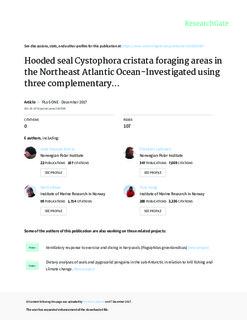| dc.description.abstract | Identifying environmental characteristics that define the ecological niche of a species is essential to understanding how changes in physical conditions might affect its distribution and other aspects of its ecology. The present study used satellite relay data loggers (SRDLs) to study habitat use by Northeast Atlantic hooded seals (N = 20; 9 adult females, 3 adult males, and 8 juveniles). Three different methods were used in combination to achieve maximum insight regarding key foraging areas for hooded seals in this region, which have decline by 85% in recent decades: 1) first passage time (FPT); 2) vertical transit rate and; 3) change in dive drift rate. Generalized additive mixed models (GAMM) were applied to each method to determine whether specific habitat characteristics were associated with foraging. Separate models were run for the post-molting and the post-breeding seasons; sex and age classes were included in the GAMMs. All three methods highlighted a few common geographic areas as being important foraging zones; however, there were also some different areas identified by the different methods, which highlights the importance of using multiple indexes when analyzing tracking and diving data to study foraging behavior. Foraging occurred most commonly in relatively shallow areas with high Sea Surface Temperatures (SST), corresponding to continental shelf areas with Atlantic Water masses. All age and sex classes overlapped spatially to some extent, but the different age and sex groups showed differences in the bathymetry of their foraging areas as well as in their vertical use of the water column. When foraging, pups dove in the upper part of the water column in relatively deep areas. Adult females foraged relatively shallowly in deep water areas too, though in shallower areas than pups. Adult males foraged close to the bottom in shallower areas. | nb_NO |
